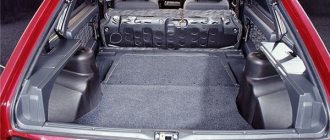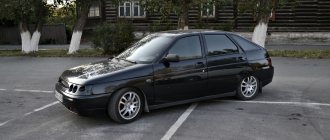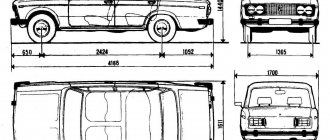The VAZ remains the most beloved and unpretentious car, which has not lost its position since the 70s of the 20th century.
It is very difficult to imagine modern roads without these eternal “workers”, regularly traveling around the cities and villages of our large and beloved homeland. Cars drive properly even in their absence, which, of course, adds respect to it.
How much does the Audi 80 gearbox weigh?
Weight, 5 speed manual transmission AKM, single-wheel drive, with 2.5 liters of oil filled, with fork and release, is 52.2 kg.
Interesting materials:
What is included in the concept of household waste? What is included in the concept of commodity-material assets? What is included in the food basket 2022? What does herbs de Provence contain? What is included in the plains? What's included in the SDK Software Development Kit? What is included in the scope of logistics? What is included in the maintenance of common property in MKD? What is included in the contents of the residential premises in the receipt? What makes up the immune system?
Power units
Let's start with the power plants, of which this model had two. The main technical characteristics of the 2101 with the first engine are as follows: a 1.2-liter unit capable of producing 64 hp. With. The Kopeyka was produced with this power plant until 1983. It was a 4-cylinder engine with in-line pistons and cylinder diameters of 76 mm, which was installed longitudinally in the engine compartment.
The gas distribution mechanism had an overhead camshaft and valves, of which there were 2 for each cylinder. The timing drive was carried out via a chain from the crankshaft. The thermal gap was adjusted by changing the length of the rocker adjusting bolts.
Engine compartment
Cooling system – liquid, forced. Coolant circulation was carried out by a centrifugal pump driven by the crankshaft. The system itself had two circles of fluid movement - small and large. The separation between them was carried out by a thermostat.
The power supply system is carburetor. The carburetor itself was a two-chamber with a sequential throttle valve opening system. Although it was designated DAAZ, it was essentially a copy of the Weber carburetor.
The lubrication system is combined. Some of the structural elements of the motor were forcibly lubricated, for which an oil pump was included in the system. But some components received lubrication by splashing.
As for speed and dynamic indicators, the VAZ-2101 with such an installation could accelerate to a maximum of 137 km/h. At the same time, the car reached the 100 km/h mark in 23 seconds.
Related link:
Description and installation of the “Lunfey” heater on a VAZ
Since 1983, the power plant on the Kopeyka was replaced with a more powerful one, which is why the car index - VAZ-21011 - has changed somewhat. Conceptually, it was identical to its predecessor, but the characteristics of the 2101 engine changed. The main changes to the engine affected the cylinder-piston group. By increasing the cylinder diameter to 79 mm, it was possible to increase the total volume to 1.3 liters, while the power increased to 69 hp. With. We also changed the power system, installing a DAAZ “Ozone” carburetor on this power plant.
With the new engine, the speed characteristics of the 2101 increased slightly, the maximum mark for the car began to be 140 km/h, but the dynamics increased more noticeably, a car with a 1.3-liter unit began to reach 100 km/h in 18 seconds.
Chassis
Now about the chassis. This car had an independent wishbone suspension installed at the front, the design of which included two wishbones, a spring and a shock absorber on each side. The right and left suspensions were connected to each other by an anti-roll bar.
The rear suspension on this car is dependent, consisting of torque rods, springs, buffers and shock absorbers.
The brake system on the VAZ-2101 is dual-circuit, with a hydraulic drive equipped with a vacuum booster. The presence of two circuits made it possible to maintain the car’s ability to brake even in the event of a breakdown in one of the circuits.
At the front, the Kopeyka used disc brakes.
Drum mechanisms were installed at the rear.
The parking brake is mechanical, cable-driven and acts on the rear mechanisms.
The steering of the car consisted of a mechanism, its main element being a worm gear.
He acted on the system of levers, through which the force from the gearbox was transmitted to the steering knuckles. This chassis design was used throughout the “Classics” family.
Body
The VAZ-2101 is a sedan, so the body layout had a three-volume layout - the engine compartment was located in front, in the middle there was a cabin designed for 5 people, and there was a luggage compartment in the back. All three parts of the body were separated from each other by partitions. The total length of the car was 4073 mm, width - 1611 mm and height - 1382 mm. The ground clearance of the car was 170 mm, and the weight of the car was 955 kg.
The engine compartment is closed, for which there was a hood.
In the front of the car there were light and sound alarm elements, headlights, a decorative radiator grille and a bumper. The front part of the VAZ-21011 model differed from its predecessor in a slightly different grille and the presence of air duct openings in the lower part of the body.
Access to the salon was provided by 4 doors. In the front part of the cabin, the car controls were installed on the left - a steering wheel and three pedals, as well as a control panel, and the gearshift lever was located in the center in front.
Related link:
Installing a heater on a VAZ car
The front seats are separate, folding, with a handbrake lever located between them. The back seat is solid.
The luggage compartment is also closed with a lid. Intended for the transportation of goods, it additionally contained tools and a spare wheel and a fuel tank with a capacity of 39 liters.
Outside, at the end of the trunk, rear light and sound alarm elements were installed - side lights, turn signals, brake lights. Model 21011 additionally had a reversing light.
In terms of safety, the VAZ-2101 was frankly weak; the first models did not even have seat belts; the car began to be equipped with them later.
How did we start production?
It was officially stated that the first six copies of the car were assembled on April 19, 1979 by four mechanics, and the first driver of the penny was Benito Guido Savoini, an instructor from an Italian company who participated in the development of the car.
Of course, this is just a beautiful legend. In fact, 90 people took part in the assembly. And even this number of specialists was not enough. Therefore, I had to work for days without sleep. People were exhausted, which led to emergency situations. For example, equipment for pumping brakes suddenly failed. I had to repair it and gain momentum at an accelerated pace in order to finish the job on time.
The first to be put on the conveyor was the black body, on which it should be clearly visible whether the car was clinging to the parts of the conveyor and whether scratches were forming. All modifications for installation were carried out on site.
There was such a fuss that we forgot to take holiday photos. Therefore, only 10 years later, a “ceremonial” photograph of the supposedly first copy of the car was taken. Of course, it’s not customary to talk about this out loud?
To be fair, it should be noted that the so-called “knee” technologies were not used at that time. There were strict quality standards, and all the necessary tools were used.
As for the components, our own have not yet been developed. Therefore, the car was assembled mainly from Italian parts. It took five whole years to transfer the car to assembly from domestic components.
Transmission
Next is the description and technical characteristics of the transmission. For both versions of this car, only one gearbox was provided - a 4-speed manual, located longitudinally. At that time, the characteristics of the VAZ-2101 gearbox were quite good.
Transmission
It received rotation from the engine through a “dry” single-plate clutch. The design of the gearbox used both helical gears with constant mesh (all forward gears) and straight ones (reverse gear). To ensure smooth shifting, all forward gears were equipped with synchronizers.
The gear ratios of each gearbox stage were as follows:
- 1st – 3.75;
- 2nd – 2.30;
- 3rd – 1.49;
- 4th – 1.0;
- Rear – 3.89;
The box was controlled manually using a lever mounted on the central tunnel in the cabin.
Rotation from the gearbox was transmitted to the rear axle via a cardan transmission running under the car in a tunnel specially made in the body.
This element was a structure of two hollow shafts connected by a hinge. An intermediate support was additionally used to secure the cardan under the car.
The rear axle consisted of a gearbox with a hypoid transmission, a differential and axle shafts. The gear ratio on the VAZ-2101 was 4.3.
Related link:
How to bleed brakes on VAZ cars











